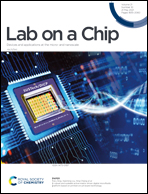Coupling fluid flow to hydrogel fluidic devices with reversible “pop-it” connections†
Abstract
Hydrogels are soft, water-based polymer gels that are increasingly used to fabricate free-standing fluidic devices for tissue and biological engineering applications. For many of these applications, pressurized liquid must be driven through the hydrogel device. To couple pressurized liquid to a hydrogel device, a common approach is to insert tubing into a hole in the gel; however, this usually results in leakage and expulsion of the tubing, and other options for coupling pressurized liquid to hydrogels remain limited. Here, we describe a simple coupling approach where microfluidic tubing is inserted into a plastic, 3D-printed bulb-shaped connector, which “pops” into a 3D-printed socket in the gel. By systematically varying the dimensions of the connector relative to those of the socket entrance, we find an optimal head-socket ratio that provides maximum resistance to leakage and expulsion. The resulting connection can withstand liquid pressures on the order of several kilopascals, three orders of magnitude greater than traditional, connector-free approaches. We also show that two-sided connectors can be used to link multiple hydrogels to one another to build complex, reconfigurable hydrogel systems from modular components. We demonstrate the potential usefulness of these connectors by established long-term nutrient flow through a 3D-printed hydrogel device containing bacteria. The simple coupling approach outlined here will enable a variety of applications in hydrogel fluidics.



 Please wait while we load your content...
Please wait while we load your content...
